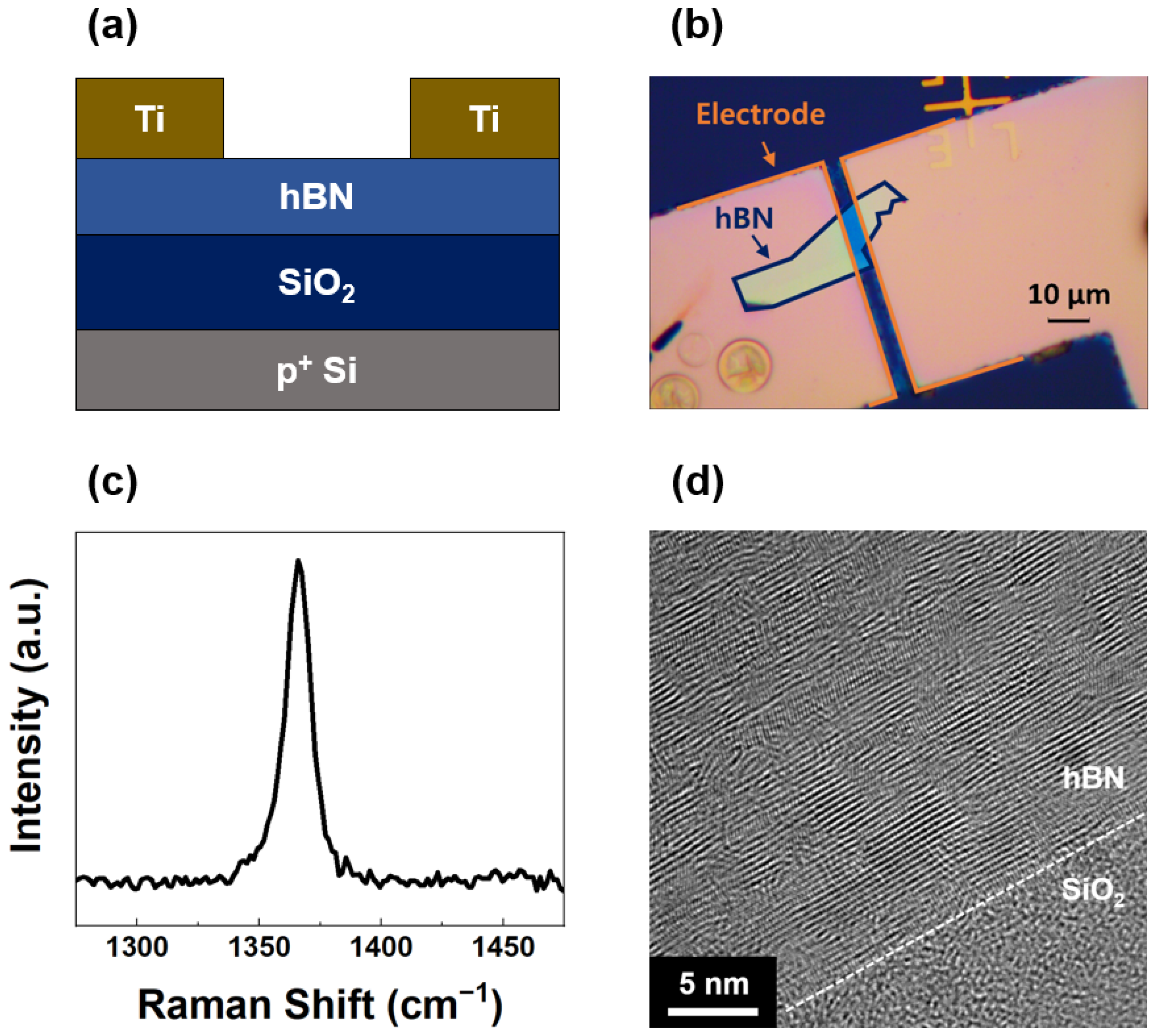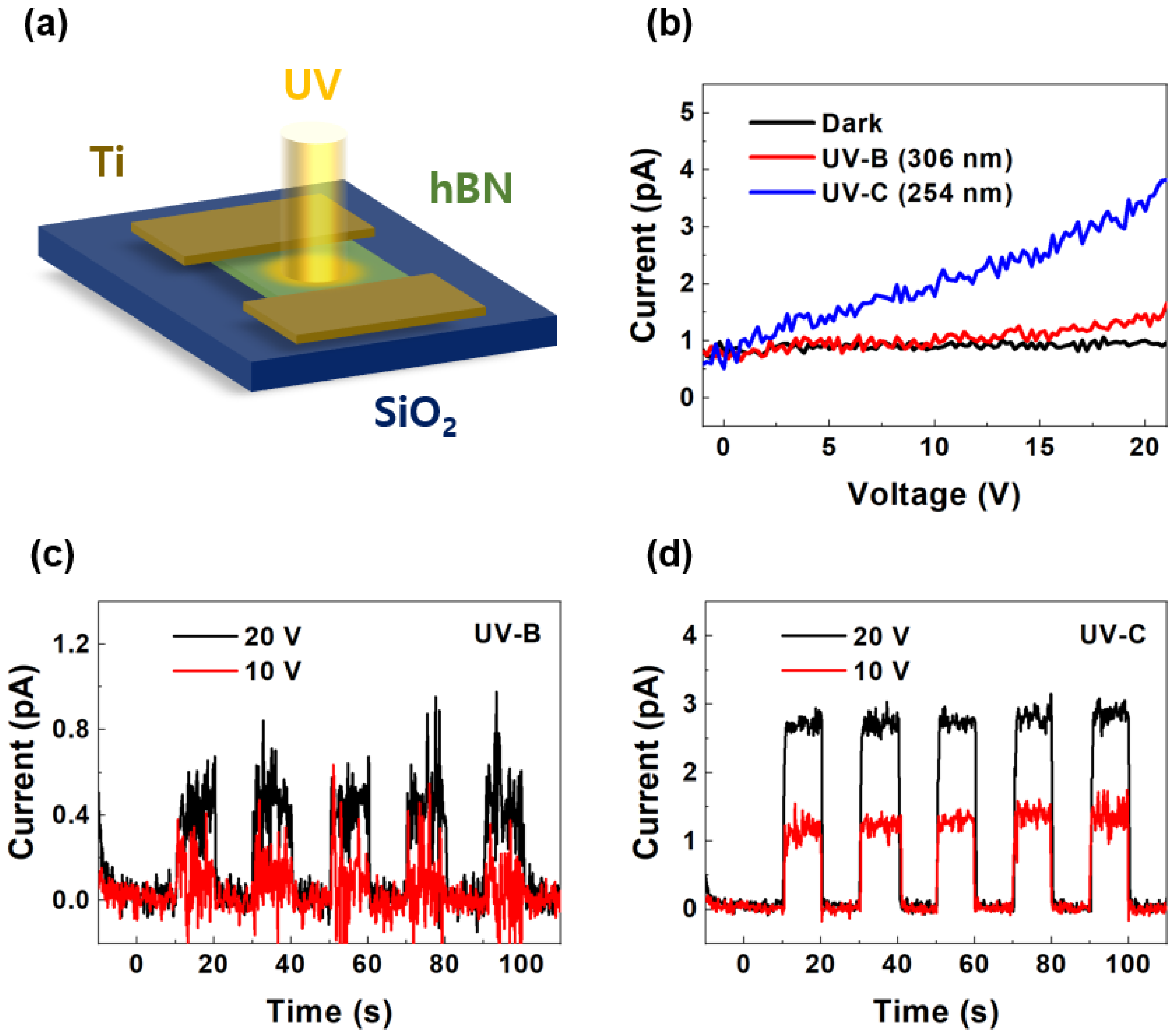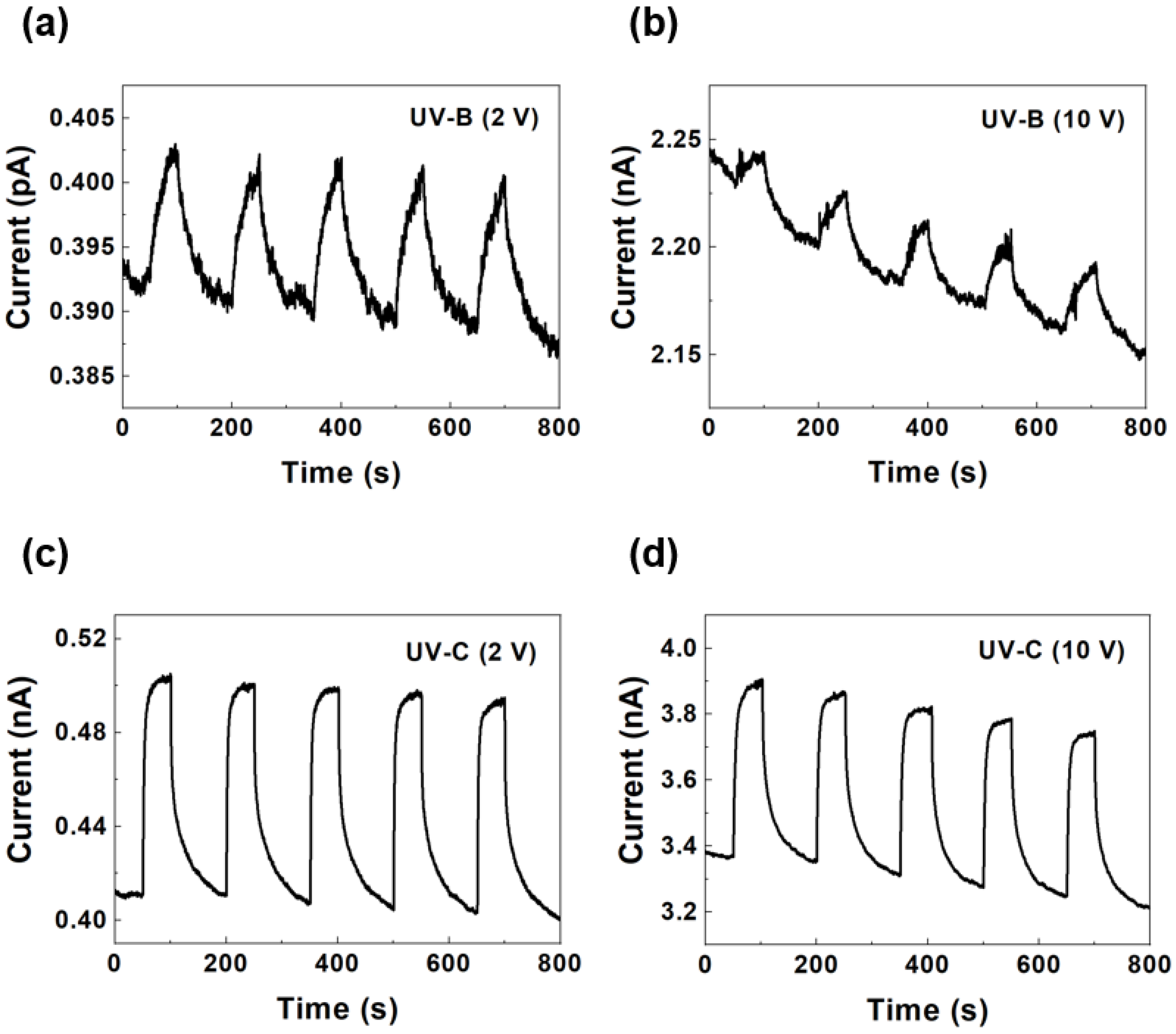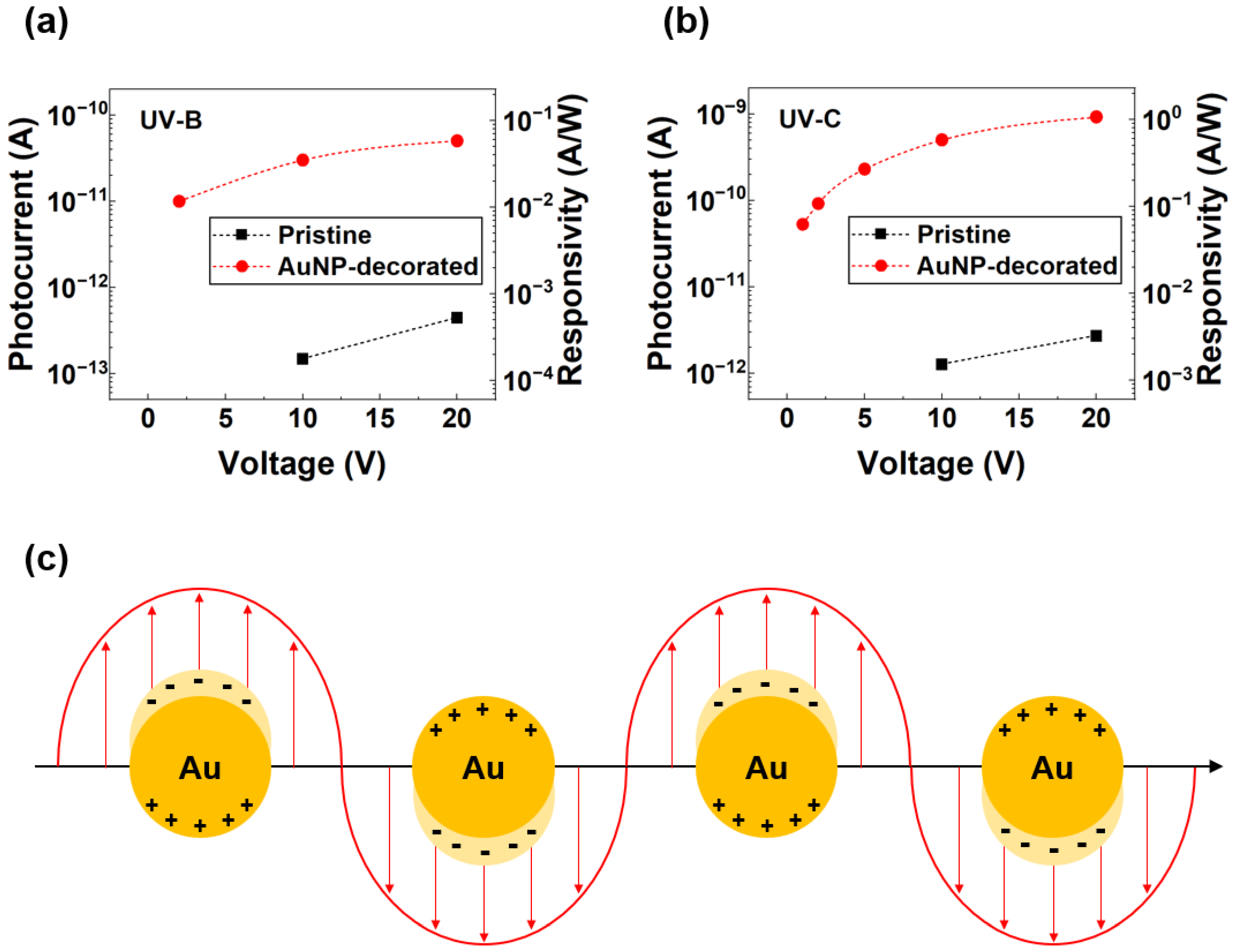Ultraviolet Photodetector Using Nanostructured Hexagonal Boron Nitride with Gold Nanoparticles
Abstract
:1. Introduction
2. Materials and Methods
2.1. Materials
2.2. Methods
3. Results and Discussion
4. Conclusions
Author Contributions
Funding
Institutional Review Board Statement
Informed Consent Statement
Data Availability Statement
Conflicts of Interest
References
- Zheng, Y.L.; Li, Y.; Tang, X.; Wang, W.L.; Li, G.Q. A Self-Powered High-Performance UV Photodetector Based on Core-Shell GaN/MoO3-x Nanorod Array Heterojunction. Adv. Opt. Mater. 2020, 8, 2000197. [Google Scholar] [CrossRef]
- Xi, Z.Y.; Liu, Z.; Yang, L.L.; Tang, K.; Li, L.; Shen, G.H.; Zhang, M.L.; Li, S.; Guo, Y.F.; Tang, W.H. Comprehensive Study on Ultra-Wide Band Gap La2O3/ε-Ga2O3 p-n Heterojunction Self-Powered Deep-UV Photodiodes for Flame Sensing. ACS Appl. Mater. Interfaces 2023, 15, 40744–40752. [Google Scholar] [CrossRef]
- Zhang, W.X.; Xu, A.Q.; Zhou, X.; Zhang, D.; Li, H.L. A Facile Synthesis of TiO2-α-Ga2O3-Based Self-Powered Broad-Band UVC/UVA Photodetector and Optical Communication Study. Materials 2024, 17, 4103. [Google Scholar] [CrossRef] [PubMed]
- Zhang, Z.; Geng, Y.; Cao, S.Q.; Chen, Z.; Gao, H.F.; Zhu, X.B.; Zhang, X.S.; Wu, Y.C. Ultraviolet Photodetectors Based on Polymer Microwire Arrays toward Wearable Medical Devices. ACS Appl. Mater. Interfaces 2022, 14, 41257–41263. [Google Scholar] [CrossRef]
- Rogalski, A.; Bielecki, Z.; Mikolajczyk, J.; Wojtas, J. Ultraviolet Photodetectors: From Photocathodes to Low-Dimensional Solids. Sensors 2023, 23, 4452. [Google Scholar] [CrossRef] [PubMed]
- Wu, W.L.; Liu, C.K.; Han, L.X.; Wang, X.Z.; Li, J.B. Wafer-scale high sensitive UV photodetectors based on novel AlGaN/n-GaN/p-GaN heterostructure HEMT. Appl. Surf. Sci. 2023, 618, 156618. [Google Scholar] [CrossRef]
- Wang, N.; Liu, Y.; Li, M.Y.; Zhao, J.T.; Zhang, X.Q.; Jiang, D.Y. Self-Powered p-NiO/n-ZnO Heterojunction Ultraviolet Photodetector Based on Honeycomb Nano-Mesh Structure. Sensors 2024, 24, 7733. [Google Scholar] [CrossRef]
- Jehad, A.K.; Fidan, M.; Ünverdi, Ö.; Çelebi, C. CVD graphene/SiC UV photodetector with enhanced spectral responsivity and response speed. Sens. Actuat. A-Phys. 2023, 355, 114309. [Google Scholar] [CrossRef]
- Alhalaili, B.; Al-Duweesh, A.; Popescu, I.N.; Vidu, R.; Vladareanu, L.; Islam, M.S. Improvement of Schottky Contacts of Gallium Oxide (Ga2O3) Nanowires for UV Applications. Sensors 2022, 22, 2048. [Google Scholar] [CrossRef]
- Abdullah, M.; Younis, M.; Sohail, M.T.; Wu, S.F.; Zhang, X.; Khan, K.; Asif, M.; Yan, P.G. Recent Progress of 2D Materials-Based Photodetectors from UV to THz Waves: Principles, Materials, and Applications. Small 2024, 20, 2402668. [Google Scholar] [CrossRef]
- Chaves, A.; Azadani, J.G.; Alsalman, H.; da Costa, D.R.; Frisenda, R.; Chaves, A.J.; Song, S.H.; Kim, Y.D.; He, D.W.; Zhou, J.D.; et al. Bandgap engineering of two-dimensional semiconductor materials. NPJ 2D Mater. Appl. 2020, 4, 29. [Google Scholar] [CrossRef]
- Bachmann, M.D.; Sharpe, A.L.; Baker, G.; Barnard, A.W.; Putzke, C.; Scaffidi, T.; Nandi, N.; McGuinness, P.H.; Zhakina, E.; Moravec, M.; et al. Directional ballistic transport in the two-dimensional metal PdCoO. Nat. Phys. 2022, 18, 819–824. [Google Scholar] [CrossRef]
- Wang, Y.N.; Gao, X.; Yang, K.N.; Gu, P.F.; Lu, X.; Zhang, S.H.; Gao, Y.C.; Ren, N.J.; Dong, B.J.; Jiang, Y.H.; et al. Quantum Hall phase in graphene engineered by interfacial charge coupling. Nat. Nanotechnol. 2022, 17, 1272–1279. [Google Scholar] [CrossRef] [PubMed]
- Ahn, E.C. 2D materials for spintronic devices. NPJ 2D Mater. Appl. 2020, 4, 17. [Google Scholar] [CrossRef]
- Cassabois, G.; Valvin, P.; Gil, B. Hexagonal boron nitride is an indirect bandgap semiconductor. Nat. Photonics 2016, 10, 262–266. [Google Scholar] [CrossRef]
- Naclerio, A.E.; Kidambi, P.R. A Review of Scalable Hexagonal Boron Nitride (h-BN) Synthesis for Present and Future Applications. Adv. Mater. 2023, 35, 2207374. [Google Scholar] [CrossRef]
- Aldalbahi, A.; Feng, P. Development of 2-D Boron Nitride Nanosheets UV Photoconductive Detectors. IEEE Trans. Electron Devices 2015, 62, 1885–1890. [Google Scholar] [CrossRef]
- Liu, H.; Meng, J.H.; Zhang, X.W.; Chen, Y.A.; Yin, Z.G.; Wang, D.G.; Wang, Y.; You, J.B.; Gao, M.L.; Jin, P. High-performance deep ultraviolet photodetectors based on few-layer hexagonal boron nitride. Nanoscale 2018, 10, 5559–5565. [Google Scholar] [CrossRef] [PubMed]
- Zhang, Q.F.; Li, Q.; Chen, R.S.; Zhang, M.Y.; Fang, W.N.; Li, J.X.; Wang, M.D.; Yun, F.; Wang, T.; Hao, Y. Large-Area Self-Assembled Hexagonal Boron Nitride Nanosheet Films for Ultralow Dark Current Vacuum-Ultraviolet Photodetectors. Adv. Funct. Mater. 2024, 34, 2315149. [Google Scholar] [CrossRef]
- Zhu, X.R.; Chen, L.; Tang, X.M.; Wang, H.Y.; Xiao, Y.H.; Gao, W.; Yin, H. Plasmonic enhancement in deep ultraviolet photoresponse of hexagonal boron nitride thin films. Appl. Phys. Lett. 2022, 120, 091109. [Google Scholar] [CrossRef]
- Ismail, M.N.S.M.; Fahri, M.A.S.A.; Tan, C.L.; Zakaria, R. Plasmon-enhanced visible photodetectors based on hexagonal boron nitride (hBN) with gold (Au), silver (Ag), and non-alloyed bimetallic (Au/Ag) nanoparticles. Sci. Rep. 2025, 15, 6. [Google Scholar] [CrossRef] [PubMed]
- Goswami, L.; Aggarwal, N.; Krishna, S.; Singh, M.; Vashishtha, P.; Singh, S.P.; Husale, S.; Pandey, R.; Gupta, G. Au-Nanoplasmonics-Mediated Surface Plasmon-Enhanced GaN Nanostructured UV Photodetectors. ACS Omega 2020, 5, 14535–14542. [Google Scholar] [CrossRef] [PubMed]
- Kumar, A.; Ahuja, J.; Mondal, A.; Bag, A. Ga-In Nanoparticle Induced UV Plasmonic Impact on Heterojunction Based Deep UV Photodetector. IEEE Trans. Nanotechnol. 2022, 21, 196–203. [Google Scholar] [CrossRef]
- Zheng, L.X.; Yang, Y.; Bowen, C.R.; Jiang, L.; Shu, Z.; He, Y.; Yang, H.L.; Xie, Z.Z.; Lu, T.X.; Hu, F.; et al. A high-performance UV photodetector with superior responsivity enabled by a synergistic photo/thermal enhancement of localized surface plasmon resonance. J. Mater. Chem. C 2023, 11, 6227–6238. [Google Scholar] [CrossRef]
- Hosseini, Z.S.; Bafrani, H.A.; Naseri, A.; Moshfegh, A.Z. High-performance UV-Vis-NIR photodetectors based on plasmonic effect in Au nanoparticles/ZnO nanofibers. Appl. Surf. Sci. 2019, 483, 1110–1117. [Google Scholar] [CrossRef]
- Kaushik, S.; Karmakar, S.; Varshney, R.K.; Sheoran, H.; Chugh, D.; Jagadish, C.; Tan, H.H.; Singh, R. Deep-Ultraviolet Photodetectors Based on Hexagonal Boron Nitride Nanosheets Enhanced by Localized Surface Plasmon Resonance in Al Nanoparticles. ACS Appl. Nano Mater. 2022, 5, 7481–7491. [Google Scholar] [CrossRef]
- Huang, J.A.; Luo, L.B. Low-Dimensional Plasmonic Photodetectors: Recent Progress and Future Opportunities. Adv. Opt. Mater. 2018, 6, 1701282. [Google Scholar] [CrossRef]
- Rahmati, B.; Hajzadeh, I.; Taheri, M.; Karimzadeh, R.; Mohajerzadeh, S.; Mohseni, S.M. Plasmonic improvement photoresponse of vertical-MoS2 nanostructure photodetector by Au nanoparticles. Appl. Surf. Sci. 2019, 490, 165–171. [Google Scholar] [CrossRef]
- Waitkus, J.; Chang, Y.; Liu, L.; Puttaswamy, S.; Chung, T.; Vargas, A.M.M.; Dollery, S.J.; O’Connell, M.R.; Cai, H.G.; Tobin, G.J.; et al. Gold Nanoparticle Enabled Localized Surface Plasmon Resonance on Unique Gold Nanomushroom Structures for On-Chip CRISPR-Cas13a Sensing. Adv. Mater. Interfaces 2023, 10, 2201261. [Google Scholar] [CrossRef] [PubMed]
- Gaspar, D.; Pimentel, A.C.; Mateus, T.; Leitao, J.P.; Soares, J.; Falcao, B.P.; Araújo, A.; Vicente, A.; Filonovich, S.A.; Aguas, H.; et al. Influence of the layer thickness in plasmonic gold nanoparticles produced by thermal evaporation. Sci. Rep. 2013, 3, 1469. [Google Scholar] [CrossRef]
- Gromov, D.G.; Dubkov, S.V.; Savitskiy, A.I.; Shaman, Y.P.; Polokhin, A.A.; Belogorokhov, I.A.; Trifonov, A.Y. Optimization of nanostructures based on Au, Ag, Au-Ag nanoparticles formed by thermal evaporation in vacuum for SERS applications. Appl. Surf. Sci. 2019, 489, 701–707. [Google Scholar] [CrossRef]
- Li, L.H.; Chen, Y. Atomically Thin Boron Nitride: Unique Properties and Applications. Adv. Funct. Mater. 2016, 26, 2594–2608. [Google Scholar] [CrossRef]
- Zhu, Y.Z.; Zhou, R.Y.; Hu, S.; Li, J.F.; Tian, Z.Q. Shell-Isolated Nanoparticle-Enhanced Raman Spectroscopy: Toward High Sensitivity and Broad Applicability. ACS Nano 2024, 18, 32287–32298. [Google Scholar] [CrossRef] [PubMed]
- Okigawa, Y.; Masuzawa, T.; Watanabe, K.; Taniguchi, T.; Yamada, T. Temperature dependence of carrier mobility in chemical vapor deposited graphene on high-pressure, high-temperature hexagonal boron nitride. Appl. Surf. Sci. 2021, 562, 150146. [Google Scholar] [CrossRef]
- Kovalenko, K.L.; Kozlovskiy, S.I.; Sharan, N.N. Electron Mobility in Molybdenum Disulfide: From Bulk to Monolayer. Phys. Status Solidi B 2020, 257, 1900635. [Google Scholar] [CrossRef]
- Chamlagain, B.; Li, Q.; Ghimire, N.J.; Chuang, H.J.; Perera, M.M.; Tu, H.G.; Xu, Y.; Pan, M.; Xaio, D.; Yan, J.Q.; et al. Mobility Improvement and Temperature Dependence in MoSe2 Field-Effect Transistors on Parylene-C Substrate. ACS Nano 2014, 8, 5079–5088. [Google Scholar] [CrossRef] [PubMed]
- Ovchinnikov, D.; Allain, A.; Huang, Y.S.; Dumcenco, D.; Kis, A. Electrical Transport Properties of Single-Layer WS. ACS Nano 2014, 8, 8174–8181. [Google Scholar] [CrossRef] [PubMed]
- Movva, H.C.P.; Rai, A.; Kang, S.; Kim, K.; Fallahazad, B.; Taniguchi, T.; Watanabe, K.; Tutuc, E.; Banerjee, S.K. High-Mobility Holes in Dual-Gated WSe2 Field-Effect Transistors. ACS Nano 2015, 9, 10402–10410. [Google Scholar] [CrossRef] [PubMed]





Disclaimer/Publisher’s Note: The statements, opinions and data contained in all publications are solely those of the individual author(s) and contributor(s) and not of MDPI and/or the editor(s). MDPI and/or the editor(s) disclaim responsibility for any injury to people or property resulting from any ideas, methods, instructions or products referred to in the content. |
© 2025 by the authors. Licensee MDPI, Basel, Switzerland. This article is an open access article distributed under the terms and conditions of the Creative Commons Attribution (CC BY) license (https://creativecommons.org/licenses/by/4.0/).
Share and Cite
Kim, D.C.; Park, H. Ultraviolet Photodetector Using Nanostructured Hexagonal Boron Nitride with Gold Nanoparticles. Sensors 2025, 25, 759. https://doi.org/10.3390/s25030759
Kim DC, Park H. Ultraviolet Photodetector Using Nanostructured Hexagonal Boron Nitride with Gold Nanoparticles. Sensors. 2025; 25(3):759. https://doi.org/10.3390/s25030759
Chicago/Turabian StyleKim, Dong Chan, and Hamin Park. 2025. "Ultraviolet Photodetector Using Nanostructured Hexagonal Boron Nitride with Gold Nanoparticles" Sensors 25, no. 3: 759. https://doi.org/10.3390/s25030759
APA StyleKim, D. C., & Park, H. (2025). Ultraviolet Photodetector Using Nanostructured Hexagonal Boron Nitride with Gold Nanoparticles. Sensors, 25(3), 759. https://doi.org/10.3390/s25030759





